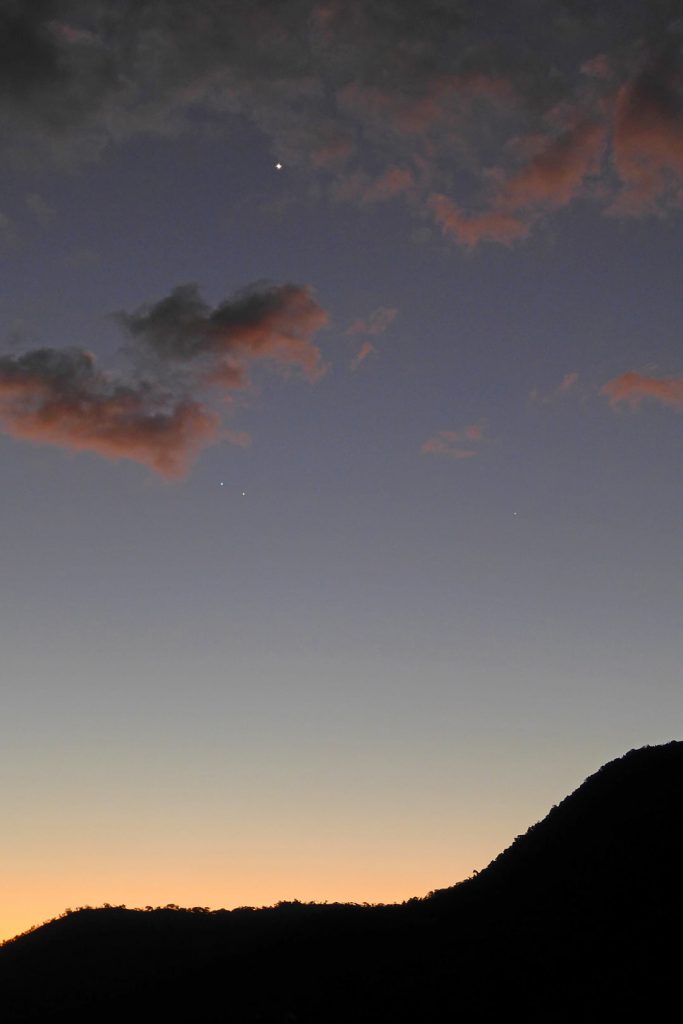
Look for Venus first
In late July 2021, look westward at dusk. As the sky darkens, you’ll notice the dazzling planet Venus. It’ll appear as the brightest “star” in the night sky. But, as evening twilight gives way to nightfall, also watch for two close-knit celestial bodies to pop out beneath Venus. They’re the planet Mars and star Regulus. People at mid-northern latitudes – like those in the northern U.S. – will probably need binoculars to spot them. But you might glimpse the furtive rendezvous of these two objects with the eye alone, if you’re in the Southern Hemisphere or northern tropics. You’ll be looking for two starlike points low in the west, near the sunset. Look just as night is falling. You’ll need to catch them before they follow the sun below the western horizon. Brilliant Venus will be shining over 100 times more brilliantly than Regulus. Meanwhile, Regulus and Mars will be about the same brightness, with Regulus just 1.6 times brighter than Mars.
Mars and Regulus in conjunction
The Mars-Regulus conjunction happens on July 29 at about 16:00 UTC. Mars will be 0.7 degrees north of Regulus at that time in right ascension (corresponding to “longitude” on an imaginary grid system superimposed on our sky). The upshot is that Mars and Regulus will be close – exceedingly close, less than two moon-diameters – apart for a couple of days. Start watching for them on July 28, if you can.
We say “if you can” because Mars and Regulus are now located very near the sun.
Northerly latitudes at a disadvantage
There are two reasons why the northern tropics and the Southern Hemisphere enjoy a better view of the Mars-Regulus conjunction. First of all, twilight lingers longer after sunset in summer than in winter. The more twilight there is in your sky, the fainter Mars and Regulus will appear. Then – depending on your latitude – just as the sky gets good and dark, Mars and Regulus might be on the verge of setting below the horizon.
What’s more, Mars and Regulus simply stay out longer after sunset at more southerly latitudes. They set sooner after the sun at more northerly latitudes.
Nightfall (end of astronomical twilight) always comes soonest after sunset at the equator. It’s now winter in the Southern Hemisphere, and summer in the Northern Hemisphere. For that reason, twilight is shorter in the Southern Hemisphere than at comparable latitudes in the Northern Hemisphere. For example, at 45 degrees north latitude, evening twilight now lasts about 25 minutes longer than at 45 degrees south latitude.
Looking for a sky almanac? EarthSky recommends…
Mars and Regulus set after nightfall in Southern Hemisphere
We give the approximate time of nightfall (end of evening twilight) and Mars’ approximate setting time for late July 2021:
40 degrees north latitude
Mars sets: 1 hour and 5 minutes after sunset
Nightfall: 1 hour and 50 minutes after sunsetEquator (0 degrees latitude)
Nightfall: 1 hour and 15 minutes after sunset
Mars sets: 1 hour and 30 minutes after sunset35 degrees south latitude
Nightfall: 1 hour and 30 minutes after sunset
Mars sets: 1 hour and 50 minutes after sunset
Find out Mars’ specific setting time in your sky at Old Farmer’s Almanac or timeanddate.com
Find out nightfall (end of astronomical twilight) via Old Farmer’s Almanac, timeanddate.com or Sunrise Sunset Calendars

Bottom line: Let brilliant Venus serve as your guide “star” to the Mars-Regulus conjunction in late July 2021. Mars and Regulus will be tougher to spot at northerly latitudes. From there, binoculars might be needed to help you to witness the furtive rendezvous of these two celestial objects in the darkening evening dusk.











